Theme Parks & Themed Entertainment
Why For are the ride vehicles for Luigi’s Flying Tires being retooled

Pirate Pete wrote in this weekend to say:
Have you been following what's been going on with the
Luigi's Flying Tires ride at DCA's Cars Land? Why exactly did they remove the
balls from that attraction? Was it a safety issue?
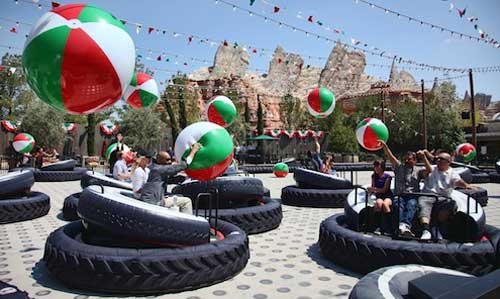
Photo by Paul Hiffmeyer. Copyright Disneyland. All rights reserved
Pirate Pete —
The balls weren't removed from this reimagining of
Disneyland's classic Flying Saucers ride because of safety concerns. But —
rather — because they were slowing down the load / unload procedure for what
was already a very slow loading / low capacity attraction. And given the large number
of Guest complaints that this newly-retooled theme park was getting from people
who've literally spent hours in line on to then have a two minute-long
experience aboard Luigi's Flying Tires … Well, the Imagineers knew that they
had to do something.
Mind you, what's kind of ironic about this is that the Spring
2012 decision to add all of those beach balls to Luigi's — give this new DCA
attraction a colorful, kinetic element (which was then supposed to distract Guests
from noticing that the Flying Tires don't exactly zoom around. That this
supposedly thrilling, interactive ride is really more of a mild, slow-moving
experience) — came very late in the game. With the Imagineers reportedly drawing
their inspiration from a piece of archival footage that they'd discovered of Disneyland's original
Flying Saucers attraction which showed this Tomorrowland attraction filled with
colorful balloons. Which were then knocked into the air as Guests deliberately
drove their Flying Saucers through those piles of balloons that were scattered
around the floor.
Of course, what the Imagineers didn't initially realize was
that this archival footage of Disneyland's Flying Saucers attraction had come
from a 1960s era episode of "Walt Disney's Wonderful World of Color."
And because the film crew which had been tasked with filming this then-still-new
Tomorrowland attraction had decided that the Saucers were (all of their own) a
little too slow-moving & bland-looking to give them the sort of colorful,
dramatic footage that they really needed for this TV show … Well, that's when
the decision was made to pour hundreds of balloons to the air cushion pen that
Disneyland's Flying Saucers floated around in.
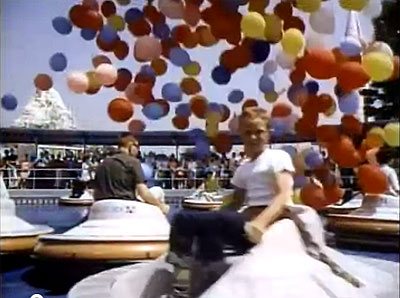
Copyright Disney Enterprises, Inc. All rights reserved
So as you can see, even back in the early 1960s, Disney
insiders were looking for ways to make this floating-on-air attraction appear to be far
more exciting & colorful than it actually was.
Anyway … Now that
all of those beach balls are gone, what are the Imagineers going to do to try
and improve the ride experience that Guests have once they climb aboard one of
Luigi's Flying Tires? Given all of this
attraction's safety protocols (i.e. each vehicle must be individually visually inspected
to make sure that all occupants are restrained by a safety belt before the Cast
Members are then allowed to fire the underground engines which then provide the
cushion of air that these oversized tires ride on), it's always going to be a
very-slow-to-load attraction. So what WDI is now concentrating on is trying to
make Luigi's Flying Tires an overall far more satisfying ride experience.
"And how exactly are they going to pull that off?,"
you ask. Well, you have to understand that — during the initial test phase of
Luigi's Flying Tires — each of these Flying Saucer-like ride vehicle was equipped
with a joy stick-type control mechanism.
Which — depending on what direction you pushed this joy stick in — sent your
Flying Tire floating off towards that side of the attraction.
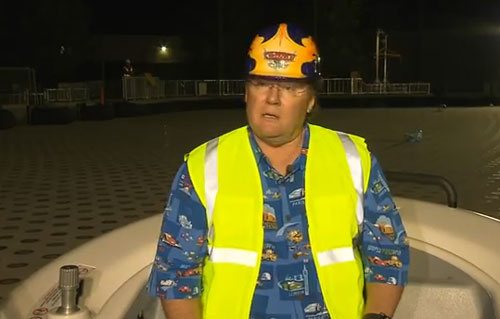
John Lasseter in an early promotional video for Luigi's Flying Saucers. Please note
— directly to the left of Lasseter — the original joy stick / ride control mechanism for
this DCA attraction. Copyright Disney Enterprises, Inc. All rights reserved
The only problem was the Disneyland Resort Cast Members who
were recruited to take part in the early, early onsite tests for Luigi's Flying
Tires found this joy stick-like ride control system confusing / difficult to
use. And the Imagineers figured that — if Cast Members (some of whom literally
spend 8 hours a day dealing with the balky ride control systems on various DCA
& Disneyland attractions) couldn't figure out how the ride control system
on Luigi's Flying Tires actually operated … Well, what chance did members of
the general public have?
So during the test-and-adjust phase for this new Cars Land
attraction, the Imagineers actually removed these joy sticks from all of the
control consoles on the Luigi's Flying Tires ride vehicles. Though — that said
— there's still 20 pounds of hardware hidden deep down inside of each of these Tires which was
supposed to respond every time you pushed that joy stick.
The Imagineers are hoping that — if they remove the rest of
that joy stick hardware (and thereby decrease the weight of each of these ride
vehicles by 20 pounds) — that single change will make Luigi's Flying Tires that
much more satisfying an attraction. That — because all of these ride vehicles will
soon be lighter — they'll then be able to zoom around the air cushioned floor of this
Cars Land attraction that much quicker. Which will make for a far more
satisfying Guest experience.
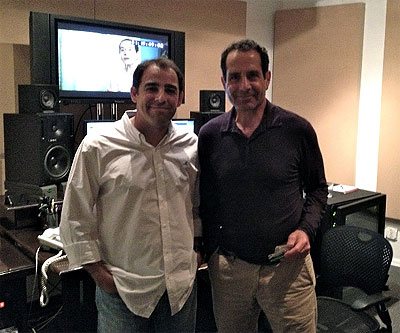
Tony Shaloub at Uptempo Studios earlier this year recording the
audio components for Luigi's Flying Tires. Copyright Uptempo
That's WDI's hope, anyway. But let's remember that these are
the same folks who brought Tony Shaloub back in at the last minute to record
all of these "Cars" – inspired Italian parody songs. With the hope
that this new musical element would then add an additional layer of fun to this
DCA attraction.
But the hard fact of the matter is — no matter how many
beach balls WDI adds and/or Italian-inspired comical songs they play — there's
just no getting around the fact that Luigi's Flying Tires (just like the
classic Disneyland ride which inspired it) is always going to be a slow loading
/ low capacity attraction with a short ride time which is also short on thrills.
Which means that DCA's Guest Relations staffers are pretty much guaranteed to
be getting a steady stream of complaints about Luigi's Flying Tires from people
who feel that they spent far too much time in line to then experience such an
underwhelming attraction.
Mind you, there used to be people who worked at Walt Disney
Imagineering who knew things like this. Veteran Imagineers who had actually
worked on the original Disneyland version of Flying Saucers and who could speak at
great length about how difficult it was to operate & properly maintain this
particular Tomorrowland attraction. Which is one of the main reasons that the
Flying Saucers only operated at
Disneyland from August of 1961 through August of 1966 before Walt
himself pulled the plug on this problematic ride.
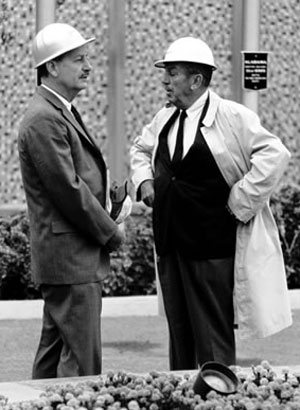
John Hench and Walt Disney onsite as the demolition
of Disneyland's original Tomorrowland gets underway
in September of 1966. Copyright Disney Enterprises,
Inc. All rights reserved
You get that, right? That Walt Disney himself — when he was
putting together his final plans for 1967's New Tomorrowland — deliberately
decided not to include a revamped version of the Flying Saucers as part of his
Disneyland redo because — even back then — this ride for slow to load,
difficult to operate and didn't deliver all that great a Guest experience.
Which perhaps explains what I witnessed on the night of June
13th of this year. Which was the night that the Disneyland Resort's PR staff held their big
Cars Land Media Party.
Let me take a moment to properly set the stage here: I'm in
line for Luigi's Flying Tires. And as I'm making my way through this
attraction's queue, I realize that there's something very familiar about the older gentleman who's
directly ahead of me in line. Eventually I realize that this guy is Disney
Legend Ron Dominguez.
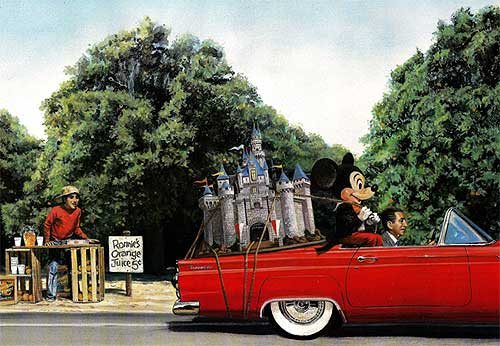
This obviously isn't how it actually went down. But — rather — its Charles Boyer's fantasy
of how young Ron Dominguez learned about what Walt Disney had in the works for the
orange groves that his family opened in Anaheim. Boyer painted this image for the
cover of the Disneyland Line (i.e. that theme park's employee newsletter) which
was published on July 17, 1980 for the 25th anniversary of this theme park.
Walt Disney Company. Copyright Disney Enterprises, Inc.
All rights reserved
For those of you who don't know: Dominguez literally is a
native Disneylander. His family actually owned 10 acres of the land that Walt
Disney had to purchase in Anaheim in order to build the Happiest Place on
Earth. And to hear Ron tell the story, the Dominguez family manse (which had
been built in Orange County back in the 1880s) was originally located in New
Orleans Square, somewhere between Pirates of the Caribbean and Cafe Orleans.
Anyway, given that Ron was looking for a summer job back in 1955, four days
before Disneyland opened to the public, Dominguez took a position as a ticket
taker at this theme park's front. And Ron then stayed on at the Disneyland
Resort for the next 39 years, eventually rising through the ranks to become
Executive Vice President of Walt Disney Attractions for the entire West Coast.
So you get what I'm saying here, right? If there's ever a
person who knew his early Disneyland history, it's Ron Dominguez. By that I mean,
this guy lived it firsthand.
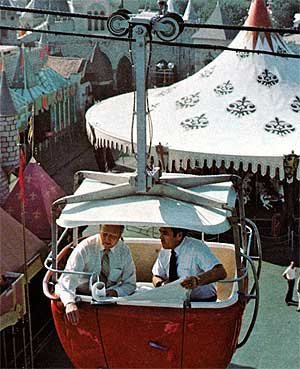
Ron Dominguez (on the right, wearing the dark tie)
rides the Tomorrowland Skyway with his then-boss
Dick Nunis in the Fall of 1980 as they discuss the
upcoming reimagining of Disneyland's Fantasyland
section. Copyright Disney Enterprises, Inc.
All rights reserved
Which is why — when Ron finally made it to the part of the Luigi's
Flying Tires queue where you can actually look out and see the ride vehicles — I just had to
laugh. Dominguez took one look at those Flying Saucers-like ride vehicles and
then loudly said "Oh, God. Not these things again." And with that,
Ron turned around and — after saying "Come on. We're getting out of
here" to the pair of women he was traveling with that night —
Dominguez quickly exited the queue.
Okay. I know. That's the reaction of a single individual.
But you gotta remember that — back in 1962 — Ron Dominguez was actually named
supervisor of Tomorrowland. So if
there's ever been a person who's intimately aware of how difficult Disneyland's
Flying Saucer attraction was to operate, it's this guy. So the fact that Ron
would immediately turn tail and run at the mere sight of Luigi's Flying Tires
… Well, that doesn't exactly bode well for the future of this Cars Land
attraction.
I'm told that — after all of the ride vehicles for Luigi's
Flying Tires have been lightened up (which should be completed sometime later
this month) — DCA's going to commission yet another Guest survey to see if the
lightened-up versions of these tires are delivering a better Guest experience.
And if not … Well, it'll be interesting to see what the Imagineers do next
here. Whether they do what WED did back in the mid-1960s, replace this Flying
Saucers / Flying Tires ride with something that's easier to operate / more of a
Guest satisfier. Maybe take that nearby expansion pad (which has been set aside
for the DCA equivalent of DHS's popular Sci-Fi Dine-In Theater restaurant) and
combine it with the property that Luigi's Flying Tires currently occupies to
create a Cars-themed attraction which has a far higher theoretical hourly ride
capacity as well as being a better overall Guest experience.
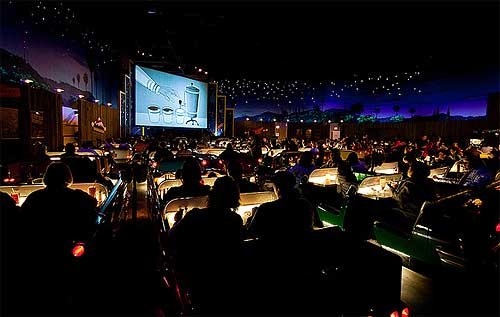
The interior of the Sci-Fi Dine-In Theater Restaurant at Disney's Hollywood Studios.
Copyright Disney Enterprises, Inc. All rights reserved
Does that answer your question, Pirate Pete? I hope so.
And just in case you're wondering, folks: Yeah, we're doing
a little experimenting with JHM's content. Seeing how this site's readers might
respond to Why For being a daily — rather than weekly — column. So if you've
got any Disney or theme park-related questions that you'd like to see answered
as part of this week's experiment, please send them along to
whyfor@jimhillmedia.com.
Your thoughts?
Theme Parks & Themed Entertainment
Disney and Macy’s 90-Year Thanksgiving Day Parade Partnership: From Mickey’s First Balloon to Minnie’s Big Debut

Now, folks, if you’re like me, Thanksgiving just wouldn’t be the same without a coffee, a cozy seat, and Macy’s Thanksgiving Day Parade on the TV. And if you’re really like me, you’re watching for one thing: Disney balloons floating down 34th Street. Ever wondered how Mickey, Donald, and soon Minnie Mouse found their way into this beloved New York tradition? Well, grab your popcorn because we’re diving into nearly 90 years of Disney’s partnership with Macy’s.
The Very First Parade and the Early Days of Balloons
The Macy’s Thanksgiving Day Parade goes way back to 1924, but if you can believe it, balloons weren’t part of the festivities until 1927. That first lineup included Felix the Cat, a dragon, and a toy soldier, all towering above the crowds. Back then, Macy’s had a pretty wild idea to end the parade: they would let the balloons drift off into the sky, free as birds. But this wasn’t just Macy’s feeling generous. Each balloon had a message attached, offering a $100 reward (about $1,800 in today’s dollars) for anyone who returned it to the flagship store on 34th Street.
And here’s where it gets interesting. This tradition carried on for a few years, right up until 1932, when Felix the Cat almost took down a plane flying over New York City! Imagine that—you’re flying into LaGuardia, and suddenly, there’s a 60-foot balloon drifting toward your wing. Needless to say, that was the end of Macy’s “fly away” stunt, and from then on, the balloons have stayed firmly grounded after the parade ends.

1934: Mickey Mouse Floats In, and Disney Joins the Parade
It was 1934 when Mickey Mouse finally made his grand debut in the Macy’s parade. Rumor has it Walt Disney himself collaborated with Macy’s on the design, and by today’s standards, that first Mickey balloon was a bit of a rough cut. This early Mickey had a hotdog-shaped body, and those oversized ears gave him a slightly lopsided look. But no one seemed to mind. Mickey was there, larger than life, floating down the streets of New York, and the crowd loved him.
Mickey wasn’t alone that year. He was joined by Pluto, Horace Horsecollar, and even the Big Bad Wolf and Practical Pig from The Three Little Pigs, making it a full Disney lineup for the first time. Back then, Disney wasn’t yet the entertainment powerhouse we know today, so for Walt, getting these characters in the parade meant making a deal. Macy’s required its star logo to be featured on each Disney balloon—a small concession that set the stage for Disney’s long-standing presence in the parade.
Duck Joins and Towers Over Mickey
A year later, in 1935, Macy’s introduced Donald Duck to the lineup, and here’s where things got interesting. Mickey may have been the first Disney character to float through the parade, but Donald made a huge splash—literally. His balloon was an enormous 60 feet tall and 65 feet long, towering over Mickey’s 40-foot frame. Donald quickly became a fan favorite, appearing in the lineup for several years before being retired.
Fast-forward a few decades, and Donald was back for a special appearance in 1984 to celebrate his 50th birthday. Macy’s dug the balloon out of storage, re-inflated it, and sent Donald down 34th Street once again, bringing a bit of nostalgia to the holiday crowd.
A Somber Parade in 2001
Now, one of my most memorable trips to the parade was in 2001, just weeks after the 9/11 attacks. Nancy and I, along with our friends, headed down to New York, and the mood was something I’ll never forget. We watched the start of the parade from Central Park West, but before that, we went to the Museum of Natural History the night before to see the balloons being inflated. They were covered in massive cargo nets, with sandbags holding them down. It’s surreal to see these enormous balloons anchored down before they’re set free.
That year, security was intense, with police lining the streets, and then-Mayor Rudy Giuliani rode on the Big Apple float to roaring applause. People cheered his name, waving and shouting as he passed. It felt like the entire city had turned out to show their resilience. Even amidst all the heightened security and tension, seeing those balloons—brought a bit of joy back to the city.

Balloon Prep: From New Jersey’s MetLife Stadium to California’s D23 Expo
Each year before the parade, Macy’s holds a rehearsal event known as Balloon Fest at MetLife Stadium in New Jersey. This is where handlers get their first crack at guiding the balloons, practicing with their parade masters, and learning the ropes—literally. It’s an entire production unto itself, with dozens of people rehearsing to make sure these enormous inflatables glide smoothly down the streets of New York on parade day.
In 2015, Macy’s took the balloon show on the road, bringing their Buzz Lightyear balloon out to California for the D23 Expo. I was lucky enough to be there, and watching Buzz get inflated piece by piece in the Anaheim Convention Center parking lot was something to behold. Each section was filled with helium in stages, and when they got around to Buzz’s lower half, well, there were more than a few gas-related jokes from the crowd.
These balloons seem to have a personality all their own, and seeing one like Buzz come to life up close—even outside of New York—had all the excitement and anticipation of the real deal.

Mickey’s Comeback as a Bandleader and Sailor Mickey
After a long hiatus, Mickey Mouse made his return to the Macy’s parade in 2000, this time sporting a new bandleader outfit. Nine years later, in 2009, Sailor Mickey joined the lineup, promoting Disney Cruise Line with a nautical twist. Over the past two decades, Disney has continued to enchant parade-goers with characters like Buzz Lightyear in 2008 and Olaf from Frozen in 2017. These balloons keep Disney’s iconic characters front and center, drawing in both longtime fans and new viewers.
But ever wonder what happens to the balloons after they reach the end of 34th Street? They don’t just disappear. Each balloon is carefully deflated, rolled up like a massive piece of laundry, and packed into storage bins. From there, they’re carted back through the Lincoln Tunnel to Macy’s Parade Studio in New Jersey, where they await their next flight.

Macy’s Disney Celebration at Hollywood Studios
In 1992, Macy’s took the spirit of the parade down to Disney-MGM Studios in Orlando. After that year’s parade, several balloons—including Santa Goofy, Kermit the Frog, and Betty Boop—were transported to Hollywood Studios, re-inflated, and anchored along New York Street as part of a holiday display. Visitors could walk through this “Macy’s New York Christmas” setup and see the balloons up close, right in the middle of the park. While this display only ran for one season, it paved the way for the Osborne Family Spectacle of Dancing Lights, which became a holiday staple at the park for years to come.

Minnie Mouse’s Long-Awaited Debut in 2024
This year, Minnie Mouse will finally join the parade, making her long-overdue debut. Macy’s is rolling out the red carpet for Minnie’s arrival with special pop-up shops across the country, where fans can find exclusive Minnie ears, blown-glass ornaments, T-shirts, and more to celebrate her first appearance in the Thanksgiving Day Parade.

For those lucky enough to catch the parade this year, you’ll see Minnie take her first float down 34th Street, decked out in her iconic red bow and polka-dot dress. Macy’s and Disney are also unveiling a new Disney Cruise Line float honoring all eight ships, including the latest, the Disney Treasure.
As always, I’ll be watching from my favorite chair, coffee in hand, as Minnie makes her grand entrance. The 98th annual Macy’s Thanksgiving Day Parade airs live on NBC, and it’s a tradition you won’t want to miss—whether you’re on 34th Street or tuning in from home.
Theme Parks & Themed Entertainment
Disney’s Forgotten Halloween Event: The Original Little Monsters on Main Street

When most Disney fans think of Halloween in the parks, they immediately picture Mickey’s Not-So-Scary Halloween Party at Walt Disney World or the Oogie Boogie Bash at Disneyland Resort. But before those events took over as the must-attend spooky celebrations, there was a little-known event at Disneyland called Little Monsters on Main Street. And its origins? Well, they go all the way back to the 1980s, during a time when America was gripped by fear—the Satanic Panic.

You see, back in the mid-1980s, parents were terrified that Halloween had become dangerous. Urban legends about drug-laced candy or razor blades hidden in apples were widespread, and many parents felt they couldn’t let their kids out of sight for even a moment. Halloween, which was once a carefree evening of trick-or-treating in the neighborhood, had suddenly become a night filled with anxiety.
This is where Disneyland’s Little Monsters on Main Street came in.

The Origins of Little Monsters on Main Street
Back in 1989, the Disneyland Community Action Team—later known as the VoluntEARS—decided to create a safe, nostalgic Halloween experience for Cast Members and their families. Many schools in the Anaheim area were struggling to provide basic school supplies to students, and the VoluntEARS saw an opportunity to combine a safe Halloween with a charitable cause. Thus, Little Monsters on Main Street was born.
This event was not open to the general public. Only Disneyland Cast Members could purchase tickets, which were initially priced at just $5 each. Cast Members could bring their kids—but only as many as were listed as dependents with HR. And even then, the park put a cap on attendance: the first event was limited to just 1,000 children.

A Unique Halloween Experience
Little Monsters on Main Street wasn’t just another Halloween party. It was designed to give kids a safe, fun environment to enjoy trick-or-treating, much like the good old days. On Halloween night in 1989, kids in costume wandered through Disneyland with their pillowcases, visiting 20 different trick-or-treat stations. They also had the chance to ride a few of their favorite Fantasyland attractions, all after the park had closed to the general public.
The event was run entirely by the VoluntEARS—about 200 of them—who built and set up all the trick-or-treat stations themselves. They arrived at Disneyland before the park closed and, as soon as the last guest exited, they began setting up stations across Main Street, Adventureland, Frontierland, Fantasyland, and Tomorrowland. The event ran from 7:30 to 9:30 p.m., and by the time the last pillowcase-wielding kid left, the VoluntEARS cleaned everything up, making sure the park was ready for the next day’s operations.
It wasn’t just candy and rides, though. The event featured unique entertainment, like a Masquerade Parade down Main Street, U.S.A., where kids could show off their costumes. And get this—Disneyland even rigged up a Cast Member dressed as a witch to fly from the top of the Matterhorn to Frontierland on the same wire that Tinker Bell uses during the fireworks. Talk about a magical Halloween experience!
The Haunted Mansion “Tip-Toe” Tour
Perhaps one of the most memorable parts of Little Monsters on Main Street was the special “tip-toe tour” of the Haunted Mansion. Now, Disneyland’s Haunted Mansion can be a pretty scary attraction for younger kids, so during this event, Disney left the doors to the Stretching Room and Portrait Gallery wide open. This allowed kids to walk through and peek at the Haunted Mansion’s spooky interiors without actually having to board the Doom Buggies. For those brave enough to ride, they could, of course, take the full trip through the Haunted Mansion—or they could take the “chicken exit” and leave, no harm done.

Growing Success and a Bigger Event
Thanks to the event’s early success, Little Monsters on Main Street grew in size. By 1991, the attendance cap had been raised to 2,000 kids, and Disneyland added more activities like magic shows and hayrides. They also extended the event’s hours, allowing kids to enjoy the festivities until 10:30 p.m.
In 2002, the event moved over to Disney California Adventure, where it could accommodate even more kids—up to 5,000 in its later years. The name was also shortened to just Little Monsters, since it was no longer held on Main Street. This safe, family-friendly Halloween event continued for several more years, with the last mention of Little Monsters appearing in the Disneyland employee newsletter in 2008. Though some Cast Members recall the event continuing until 2012, it eventually made way for Disney’s more public-facing Halloween events.

From Little Monsters to Mickey’s Not-So-Scary and Oogie Boogie Bash
Starting in the early 2000s, Disney began realizing the potential of Halloween-themed after-hours events for the general public. These early versions of Mickey’s Halloween Party and Mickey’s Halloween Treat eventually evolved into today’s Mickey’s Not-So-Scary Halloween Party and Oogie Boogie Bash. Unfortunately, this also marked the end of the intimate, Cast Member-exclusive Little Monsters event, but it paved the way for the large-scale Halloween celebrations we know and love today.
While it’s bittersweet to see Little Monsters on Main Street fade into Disney history, its legacy lives on through these modern Halloween parties. And even though Cast Members now receive discounted tickets to Mickey’s Not-So-Scary and Oogie Boogie Bash, the special charm of an event created specifically for Disney’s employees and their families remains something worth remembering.
The Merch: A Piece of Little Monsters History
For Disney collectors, the exclusive merchandise created for Little Monsters on Main Street is still out there. You can find pins, name tags, and themed pillowcases on sites like eBay. One of the coolest collectibles is a 1997 cloisonné pin set featuring Huey, Dewey, and Louie dressed as characters from Hercules. Other sets paid tribute to the Main Street Electrical Parade and Pocahontas, while the pillowcases were uniquely designed for each year of the event.

While Little Monsters on Main Street may be gone, it’s a fascinating piece of Disneyland history that played a huge role in shaping the Halloween celebrations we enjoy at Disney parks today.
Want to hear more behind-the-scenes stories like this? Be sure to check out I Want That Too, where Lauren and I dive deep into the history behind Disney’s most beloved attractions, events, and of course, merchandise!
Theme Parks & Themed Entertainment
The Story of Mickey’s Not-So-Scary Halloween Party: From One Night to a Halloween Family Tradition

The spooky season is already in full swing at Disney parks on both coasts. On August 9th, the first of 38 Mickey’s Not-So-Scary Halloween Party (MNSSHP) nights for 2024 kicked off at Florida’s Magic Kingdom. Meanwhile, over at Disney California Adventure, the Oogie Boogie Bash began on August 23rd and is completely sold out across its 27 dates this year.
Looking back, it’s incredible to think about how these Halloween-themed events have grown. But for Disney, the idea of charging guests for Halloween fun wasn’t always a given. In fact, when the very first Mickey’s Not-So-Scary Halloween Party debuted on October 31, 1995, it was a modest one-night-only affair. Compare that to the near month-long festivities we see today, and it’s clear that Disney’s approach to Halloween has evolved considerably.
A Not-So-Scary Beginning
I was fortunate enough to attend that very first MNSSHP back in 1995, along with my then 18-month-old daughter Alice and her mom, Michelle. Tickets were a mere $16.95 (I know, can you imagine?), and we pushed Alice around in her sturdy Emmaljunga stroller—Swedish-built and about the size of a small car. Cast Members, charmed by her cuteness, absolutely loaded us up with candy. By the end of the night, we had about 30 pounds of fun-sized candy bars, making that push up to the monorail a bit more challenging.

This Halloween event was Disney’s response to the growing popularity of Universal Studios Florida’s own Halloween hard ticket event, which started in 1991 as “Fright Nights” before being rebranded as “Halloween Horror Nights” the following year. Universal’s gamble on a horror-themed experience helped salvage what had been a shaky opening for their park, and by 1993, Halloween Horror Nights was a seven-night event, with ticket prices climbing as high as $35. Universal had stumbled upon a goldmine, and Disney took notice.
A Different Approach
Now, here’s where Disney’s unique strategy comes into play. While Universal embraced the gory, scare-filled world of horror, Disney knew that wasn’t their brand. Instead of competing directly with blood and jump-scares, Disney leaned into what they did best: creating magical, family-friendly experiences.
Thus, Mickey’s Not-So-Scary Halloween Party was born. The focus was on fun and whimsy, not fear. Families could bring their small children without worrying about them being terrified by a chainsaw-wielding maniac around the next corner. This event wasn’t just a Halloween party—it was an extension of the Disney magic that guests had come to expect from the parks.
Disney had some experience with seasonal after-hours events, most notably Mickey’s Very Merry Christmas Party, which had started in 1983. But the Halloween party was different, as the Magic Kingdom wasn’t yet decked out in Halloween decor the way it is today. Disney had to create a spooky (but not too spooky) atmosphere using temporary props, fog machines, and, of course, lots of candy.
A key addition to that first event? The debut of the Headless Horseman, who made his eerie appearance in Liberty Square, riding a massive black Percheron. It wasn’t as elaborate as the Boo-to-You Parade we see today, but it marked the beginning of a beloved Disney Halloween tradition.
A Modest Start but a Big Future
That first MNSSHP in 1995 was seen as a trial run. As Disney World spokesman Greg Albrecht told the Orlando Sentinel, “If it’s successful, we’ll do it again.” And while attendance was sparse that night, there was clearly potential. By 1997, the event expanded to two nights, and by 1999, Mickey’s Not-So-Scary Halloween Party had grown into a multi-night celebration with a full-fledged parade. Today, in 2024, it’s a staple of the fall season at Walt Disney World, offering 38 nights of trick-or-treating, character meet-and-greets, and special entertainment.
Universal’s Influence

It’s interesting to reflect on how Disney’s Halloween event might never have existed without the competition from Universal. Just as “The Wizarding World of Harry Potter” forced Disney to step up their game with “Star Wars: Galaxy’s Edge,” Universal’s success with Halloween Horror Nights likely spurred Disney into action with MNSSHP. The friendly rivalry between the two parks has continually pushed both to offer more to their guests, and we’re all better off because of it.
So the next time you find yourself trick-or-treating through the Magic Kingdom, watching the Headless Horseman gallop by, or marveling at the seasonal fireworks, take a moment to appreciate how this delightful tradition came to be—all thanks to a little competition and Disney’s commitment to creating not-so-scary magic.
For more Disney history and behind-the-scenes stories, check out the latest episodes of the I Want That Too podcast on the Jim Hill Media network.
-

 History10 months ago
History10 months agoThe Evolution and History of Mickey’s ToonTown
-

 History11 months ago
History11 months agoUnpacking the History of the Pixar Place Hotel
-

 History11 months ago
History11 months agoFrom Birthday Wishes to Toontown Dreams: How Toontown Came to Be
-

 Film & Movies8 months ago
Film & Movies8 months agoHow Disney’s “Bambi” led to the creation of Smokey Bear
-

 News & Press Releases10 months ago
News & Press Releases10 months agoNew Updates and Exclusive Content from Jim Hill Media: Disney, Universal, and More
-

 Merchandise8 months ago
Merchandise8 months agoIntroducing “I Want That Too” – The Ultimate Disney Merchandise Podcast
-

 Theme Parks & Themed Entertainment3 months ago
Theme Parks & Themed Entertainment3 months agoDisney’s Forgotten Halloween Event: The Original Little Monsters on Main Street
-

 Film & Movies3 months ago
Film & Movies3 months agoHow “An American Tail” Led to Disney’s “Hocus Pocus”








